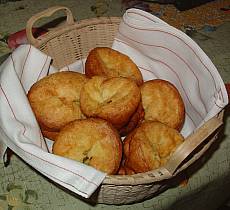Popover
An overview of popovers in culinary arts
Overview[edit | edit source]
A popover is a light, hollow roll made from an egg batter, similar to Yorkshire pudding, typically baked in muffin tins or dedicated popover pans. The name "popover" comes from the fact that the batter "pops" over the top of the pan while baking.
History[edit | edit source]
Popovers are an American version of Yorkshire pudding and have been a part of American cuisine since the 19th century. They are believed to have originated in the United States, with the first known reference appearing in a letter dated 1850.
Preparation[edit | edit source]
The basic ingredients for popovers include flour, milk, eggs, and butter. The batter is mixed until smooth and then poured into preheated pans. The high temperature of the oven causes the batter to rise quickly, creating a hollow center and a crisp exterior.
Baking Tips[edit | edit source]
- Preheat the oven and the baking pan to ensure a rapid rise.
- Do not open the oven door during baking, as this can cause the popovers to collapse.
- Serve immediately after baking for the best texture.
Variations[edit | edit source]
Popovers can be served plain or with various fillings and toppings. Common variations include:
- Cheese Popovers: Adding grated cheese to the batter for a savory flavor.
- Herb Popovers: Incorporating fresh herbs such as rosemary or thyme.
- Sweet Popovers: Adding sugar and vanilla to the batter for a dessert version.
Serving Suggestions[edit | edit source]
Popovers are versatile and can be served as a side dish, a breakfast item, or a dessert. They pair well with:
- Butter and jam for a sweet treat.
- Gravy or soup for a savory meal.
- Whipped cream and berries for a dessert option.
Related pages[edit | edit source]
Search WikiMD
Ad.Tired of being Overweight? Try W8MD's physician weight loss program.
Semaglutide (Ozempic / Wegovy and Tirzepatide (Mounjaro / Zepbound) available.
Advertise on WikiMD
|
WikiMD's Wellness Encyclopedia |
| Let Food Be Thy Medicine Medicine Thy Food - Hippocrates |
Translate this page: - East Asian
中文,
日本,
한국어,
South Asian
हिन्दी,
தமிழ்,
తెలుగు,
Urdu,
ಕನ್ನಡ,
Southeast Asian
Indonesian,
Vietnamese,
Thai,
မြန်မာဘာသာ,
বাংলা
European
español,
Deutsch,
français,
Greek,
português do Brasil,
polski,
română,
русский,
Nederlands,
norsk,
svenska,
suomi,
Italian
Middle Eastern & African
عربى,
Turkish,
Persian,
Hebrew,
Afrikaans,
isiZulu,
Kiswahili,
Other
Bulgarian,
Hungarian,
Czech,
Swedish,
മലയാളം,
मराठी,
ਪੰਜਾਬੀ,
ગુજરાતી,
Portuguese,
Ukrainian
Medical Disclaimer: WikiMD is not a substitute for professional medical advice. The information on WikiMD is provided as an information resource only, may be incorrect, outdated or misleading, and is not to be used or relied on for any diagnostic or treatment purposes. Please consult your health care provider before making any healthcare decisions or for guidance about a specific medical condition. WikiMD expressly disclaims responsibility, and shall have no liability, for any damages, loss, injury, or liability whatsoever suffered as a result of your reliance on the information contained in this site. By visiting this site you agree to the foregoing terms and conditions, which may from time to time be changed or supplemented by WikiMD. If you do not agree to the foregoing terms and conditions, you should not enter or use this site. See full disclaimer.
Credits:Most images are courtesy of Wikimedia commons, and templates, categories Wikipedia, licensed under CC BY SA or similar.
Contributors: Prab R. Tumpati, MD

